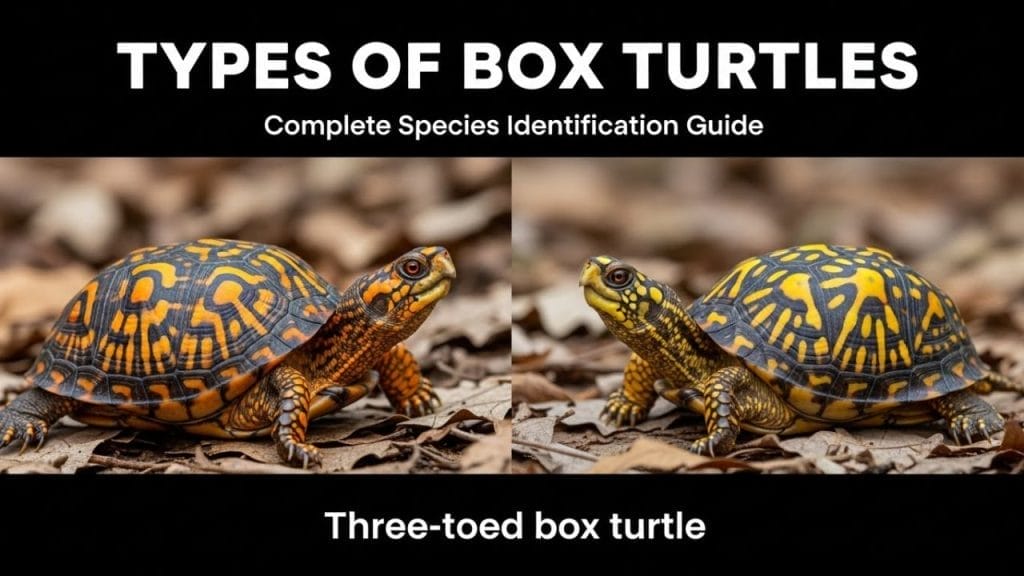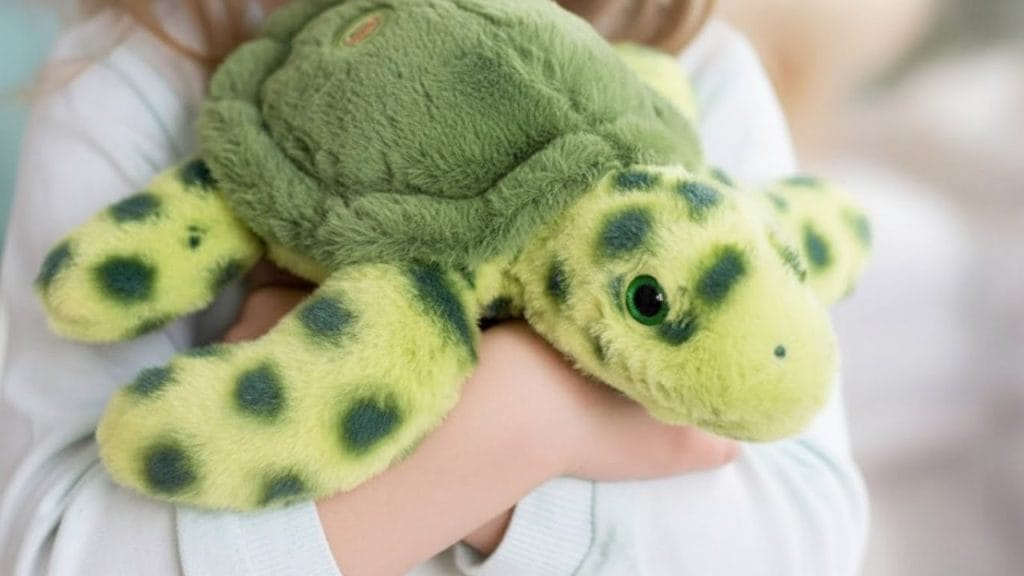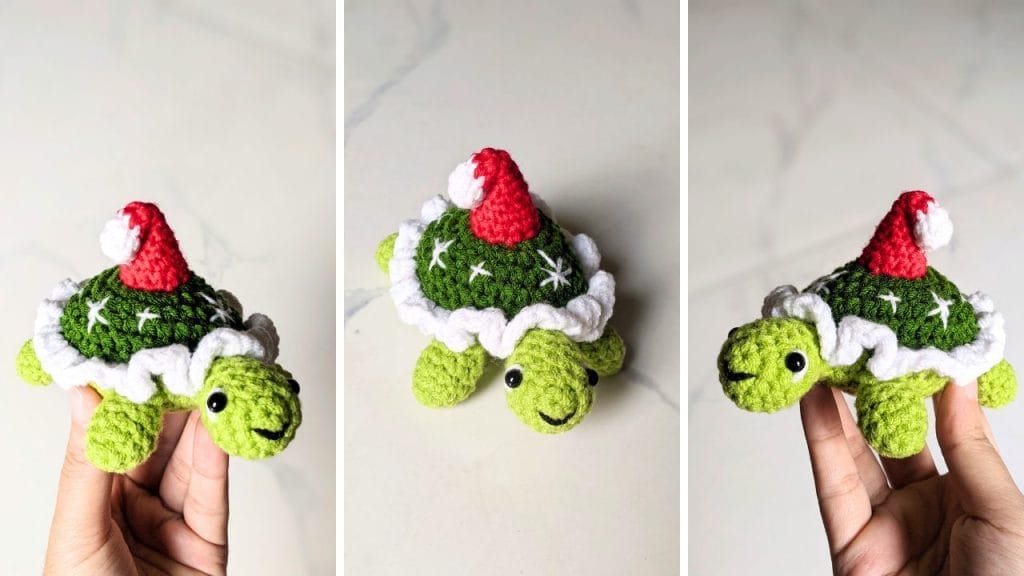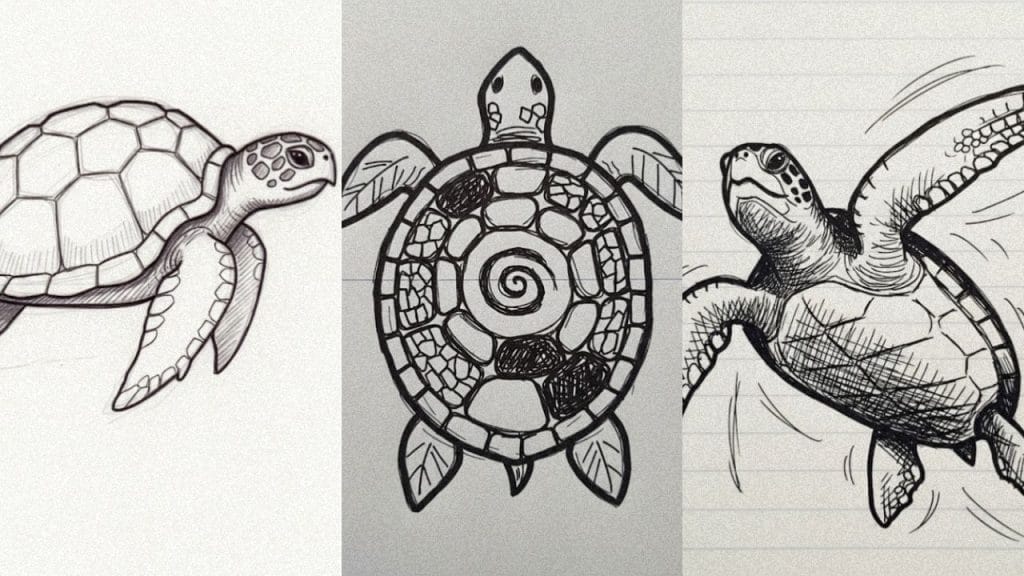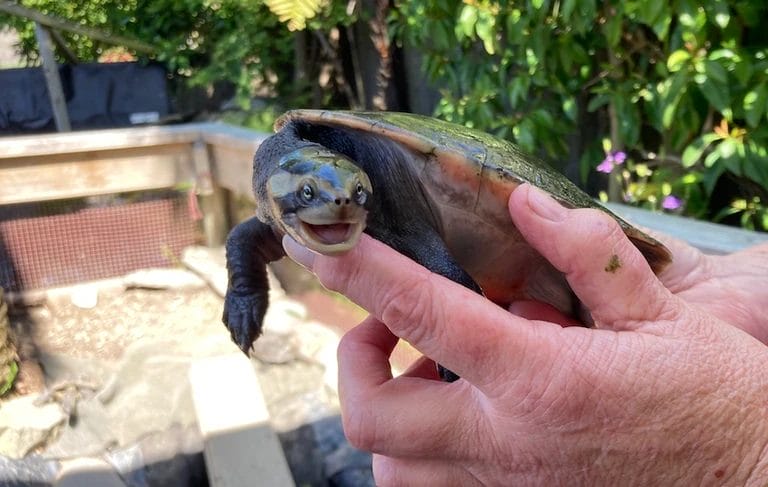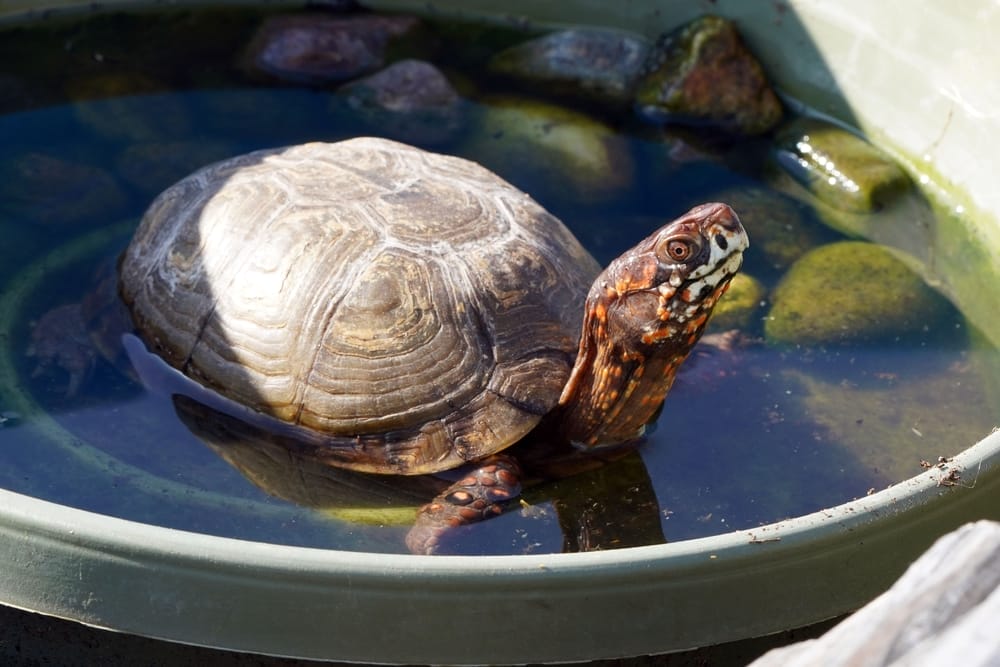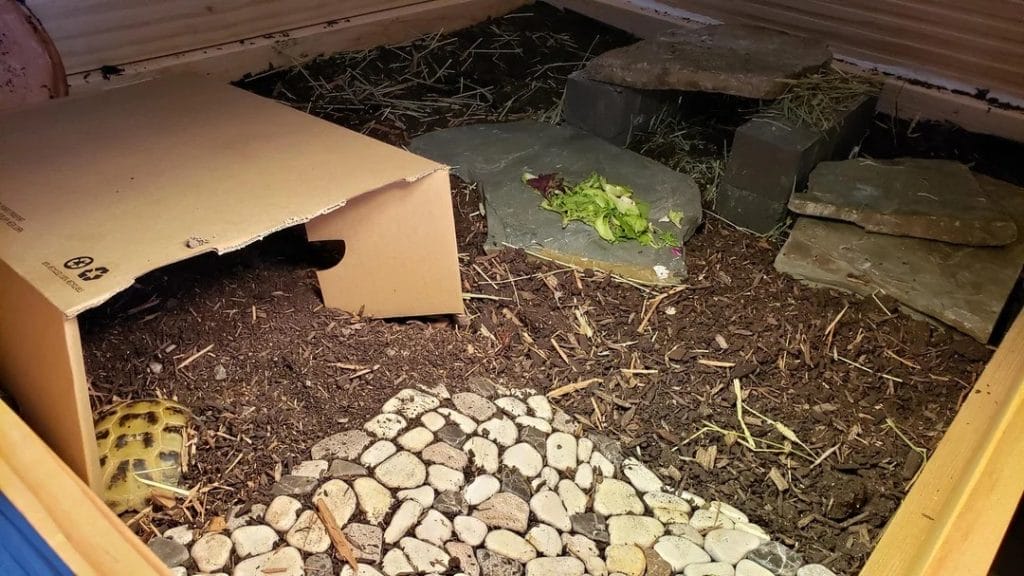5 Best Substrate Options For Sulcata Tortoise [Buying Guide]

This post was created with help from AI tools and carefully reviewed by a human (Muntaseer Rahman). For more on how we use AI on this site, check out our Editorial Policy.
We all resent artificial substrates due to their reputation for being toxic. But the sad part is that we can not use just any available bedding in the market without checking their quality. So, to save you from hassle, I have listed the top substrate options for the Sulcata tortoise here in this article.
Best Substrates for Sulcata tortoises are:
- Natural Substrate: Cypress mulch, sphagnum moss, soil mix, coconut barks, etc.
- Commercial Substrate: All natural beddings, compressed coconut bricks, etc.
Among these options, which substrate to choose for your Sulcata tortoise? What are the pros and cons of this bedding? The following article includes everything you need to know.
Substrate Works With Other Equipment
You’ve chosen your substrate. Here’s how it connects to other equipment needs:
Substrate + Temperature:
Substrate affects how heat distributes in the enclosure:
- Deep substrate = cooler at the bottom (good for burrowing to escape heat)
- Moist substrate = evaporative cooling effect
- Basking area should have thinner substrate or flat surface (retains heat)
You need thermometers to verify the temperature gradient actually exists in YOUR setup.
Substrate + Humidity:
Substrate moisture + ambient temperature + ventilation = actual humidity level
You need a hygrometer to verify humidity is species-appropriate.
Substrate + Feeding:
Every substrate in this article mentions impaction risk from ingestion.
You need feeding dishes to minimize substrate consumption during meals.
Equipment Checklist for Substrate Success:
| Equipment | Why It Matters for Substrate |
|---|---|
| Hygrometer | Verify substrate is maintaining correct humidity |
| Thermometer | Verify temperature gradient through substrate depth |
| Feeding dishes | Reduce substrate ingestion risk |
| Misting bottle/system | Maintain substrate moisture |
Complete Setup Guide:
- Substrate Recommendations – More details on substrate options
- Humidity & Temperature Monitoring – Verify your substrate is working
- Feeding Dishes – Reduce impaction risk
- Complete Tortoise Setup – Everything else you need
5 Best Substrate Options For Sulcata Tortoise
This Hilarious Turtle Book Might Know Your Pet Better Than You Do
Let’s be real—most turtle care guides feel like reading a textbook written by a sleep-deprived zookeeper.
This one’s not that.
Told from the snarky point of view of a grumpy, judgmental turtle, 21 Turtle Truths You’ll Never Read in a Care Guide is packed with sarcasm, sass, and surprisingly useful insights.
And hey—you don’t have to commit to the whole thing just yet.
Grab 2 free truths from the ebook and get a taste of what your turtle really thinks about your setup, your food choices, and that weird plastic palm tree.
It’s funny, it’s honest, and if you’ve ever owned a turtle who glares at you like you’re the problem—you’ll feel seen.
1. Exo Terra Plantation
Exo Terra Plantation substrate is a natural soil made of coconut husk fibres. Those fibres are first compressed and then packaged in the company label.
Exo Terra Plantation can be the top choice for Sulcata tortoises for two basic reasons,

- Firstly, the Exo Terra Plantation substrate can hold moisture. As Sulcata tortoises enjoy high humidity, this substrate will make a compatible base for their habitat.
- Secondly, this substrate is suitable for reptiles and amphibians who burrow. As we know, Sulcata tortoises also love digging into the soil from time to time. Hence, this Exo Terra Plantation substrate is perfect for them.
Besides, the moisture retaining capacity of the Exo Terra Plantation also allows a perfect growth of terrarium plants. Moreover, this substrate can be used as an incubator medium for Sulcata tortoise eggs.
Another reason for Exo Terra Plantation substrate recommendation is its easy-to-use and easy-to-maintenance quality.
The substrate is available in both loose and compressed forms. In any case, a little amount of water has to be added to the soil to attain the desired density. Then you can layer up the habitat bottom with 2 – 4 inches of this coconut husk fibres.
Regarding maintenance, spot cleaning the faeces and wastes is recommneded. Also, you should replace the substrate every 6 months.
Pros
- Natural coconut fibres
- Allow plantation
- Retain moisture
- Suitable for burrowing
Cons
- Risk of mites and bacterial growth
Check Out Details On Exo Terra Plantation Soil
Perfect Wooden Tortoise House For Outdoor & Indoor!
This tortoise house isn’t cheap — but that’s because it’s not your average wooden box.
Built with durable wood, a waterproof liner, and smart design features like a sunbathing area and a hideout zone, the Aivituvin Large Wooden Habitat is made to last.
It’s perfect for tortoises or box turtles, indoors or out. And yep, it even has detachable legs.
If you’re serious about giving your tortoise a safe, comfy home without building one from scratch, this is the one.
👉 Grab the Aivituvin Tortoise House here — it’s currently $10 off.
2. Reptile Science Terrarium Sand
If you decide to go with a sandy substrate for your Sulcata tortoise, you can try the Reptile Science Terrarium Sand.
I know what you are thinking. Sand is not good for Sulcata tortoises. What if the pet ends up eating the substrate?

Well, the brand has thought this through and made some changes in the sandy substrate.
The Reptile Science Terrarium Sand is 100% natural orbicular coarse grain sand. As the brand has marketed the product, the substrate is 100% calcium carbonate and safe for digestion.
On top of that, the sand includes no silica or phosphate that causes impaction in Sulcata tortoises. Instead, you will find elements like Strontium, Potassium, and Magnesium, which are considered healthy for pets.
Therefore, if your Sulcata tortoise takes a chunk of this substrate, it will do just fine. Yet, you can mix this sandy substrate with loose soil to make it safer and more compatible with the tortoise habitat.
The bright side of this Reptile Science Terrarium Sand is that it can retain water. Hence, the Sulcata tortoise can burrow in the substrate and enjoy moisture. The water retention property also comes in handy while cleaning the mess.
However, the Reptile Science Terrarium sand is odourless and does not create a mess easily. So, your Sulcata tortoise enclosure will look cleaner with a neutralized smell.
Maintenance is also easy. Just take up the dump daily and replace the sand every 4 – 6 months. Furthermore, one bag of this Reptile Terrarium Sand can serve you for over a year, depending on the usage.
Pros
- Edible sand
- Hold moisture
- Cleaner
- Odourless
- Value for money
Cons
- Leak water
- Risk of bacterial infection
Check Out More Details On Reptile Science Terrarium Sand
3. Zoo Med Forest Floor
Mulches are safe to use as substrate in the Sulcata tortoise terrarium. From this thought, the popular brand Zoo Med has added the Forest Floor substrate to its product list.
The Zoo Med Forest Floor is made of 100% ground cypress barks. As mulches of cypress and fir are popular substrate options for Sulcata tortoises, this product is also safe for pets.

I personally prefer this cypress bark forest floor substrate because,
- The cypress barks are not heat-treated and can retain significant moisture.
- It is easier to add plants to this substrate.
- The ground barks can be used for egg incubation.
- The texture and density of this mixture offer a natural forest-like flooring in the terrarium.
The Zoo Med Forest Floor is better than many other branded mulches available in the market. However, you should avoid products mixed with fertilizers, chemicals, or pesticides at any cost.
Laying out the Zoo Med Forest Floor is also easy.
You can use the substrate straight out of the bag. Then, all you have to do is to mist the barks for high humidity.
Spot cleaning and replacing the substrate twice a year will ensure cleanliness. Also, you can bake the barks at a low temperature to kill any parasites growing in them.
Pros
- All-natural
- Not dusty
- Add a natural look to the terrarium
- Easy maintenance
- Suitable for digging and burrowing
Cons
- Not edible
- Ingestion can cause impaction in the tortoises
- Eye problem
Check Out More Details On Zoo Med Forest Floor
4. Zoo Med Eco Earth
Coconut husk fibres are always the top choice as a Sulcata tortoise substrate. Hence, there are wide varieties of this product available in the market.
The Zoo Med Eco Earth is a natural and eco-friendly substrate. Its main attraction point is the bioactive enclosure set-up process. As per the label, this substrate can break down waste and promote a cleaner and odourless enclosure.

Besides, like other substrates, the Zoo Med Eco Earth can hold moisture, maintaining a humid environment. Moreover, the layer up of this coconut fibre makes it perfect for digging and burrowing.
Not to mention its ability to grow plants inside the terrarium. Experts suggest combining this substrate with hydro balls or other natural soils to create a natural drainage system for the plants.
As the Zoo Med Eco Earth comes as a brick, you have to hand break the product first. Then use a little water to soften the fibres before putting them at the bottom. Daily misting is enough to create a humid environment inside the habitat.
You can follow the traditional spot cleaning and twice-a-month replacement to maintain this Zoo Med Eco Earth Substrate.
Pros
- 100% Natural
- Bioactive properties
- Clean and odourless
- Effective for plants
- Provide burrowing spots
- Lesser risk of molds
Cons
- Not edible
- Risk of impaction
- Carry mitten
Check Out More Details On Zoo Med Eco Earth
5. Fluker’s 36005 Repta-Bark All Natural Bedding
All-natural bedding has recently caught tremendous attention. The substrate is made of organic ingredients, which suits the requirements of the Sulcata tortoises.
While other substrates tend to leak moisture, Fluker’s All Natural Bedding can prevent excessive water absorption. Hence, no more mess in the terrarium.

Not only that. The thick layers of this substrate allow the Sulcata tortoises to burrow as much as they want. Moreover, as the flakes are soft and moist, the tortoises do not get hurt when digging. Furthermore, the water retention quality makes the substrate perfect for adding small plants.
Pros
- All natural ingredients
- Expel excess water
- Absorb waste
- Easy maintenance
- Less dusty
- Affordable
Cons
- Risk of bacterial infection
- Not suitable for digestion
- Get dirty when damp
Check Out Details On Fluker’s 36005 Repta-Bark All Natural Bedding

Natural Substrates And Their Related Problems
1. Wood Chips
While many owners think wood chips make excellent substrates, others seem to discourage this idea. Well, of course, each group has its own reasons. But here is what I have found relevant.
I personally find wood chips very inconvenient as Sulcata tortoise substrate. The pets can get hurt by the wood splinters easily. On top of that, if they eat the chips, internal organ damage can occur. Not to mention the less fire-resistant properties of woods that make it a no-go as substrate.
However, combining wood chips with other ingredients can become a suitable substrate for the Sulcata tortoises.
2. Pine And Cedar
Do not listen to anyone advising on using pine and cedar substrate as Sulcata tortoise substrate. These are much worse than wood chips.
Yes, the pine and cedar can offer water retention and burrowing height to an extent. But these ingredients are highly toxic for the Sulcata tortoises. So, ingestion can lead to impaction and severe health damage.
3. Papers
Water has high absorption properties and can offer excellent humidity inside the environment. Hence, paper substrates can surely eliminate the dehydration issue in tortoises.
But wait.
Except for the cheap price, availability and high moisture retention properties, paper is for no good. It gets sticky easily, and the tortoises can not burrow in a paper substrate. Therefore, avoid layering up the Sulcata tortoise enclosure with newspapers.
4. Sand
If you are talking about pure sand, it is a no-go.
Sand particles are sharp and can harm the tortoise skins. Not only that. The Sulcata tortoises will choke on grains and suffer from impaction upon ingesting the sandy substrates. Besides, sand can cause eye issues in pets.
Hence, using pure sand as Sulcata tortoise substrate is not advisable.
But you can definitely mix the sand with loose soil and other ingredients to minimize the harm. Recently, calcium-based sands have become very popular. This is because those substrates contain coarse grains and no harmful ingredients like silica or phosphate. Also, calcium is safe and edible for tortoises.
5. Mulches
Cypress and fir mulches are commonly used as Sulcata tortoise beddings. These elements are safe and have no major impact on the pet’s health. Moreover, these mulches’ water retention quality, burrowing thickness, and easy maintenance properties are quite appreciable.
However, mulches with preservatives, additives, or chemicals adversely affect the Sulcata tortoise’s health. Thus, any chemically processed mulches should be avoided.
6. Peat Moss
The sphagnum moss and peat moss are from the same family but have basic differences. For example, peat mosses are cheaper and have discounted properties.
You can use peat moss as Sulcata tortoise habitat bedding. But here are a few things you should remember.
The peat moss does not absorb moisture like sphagnum moss or any other substrate. So, again, the dryness of the bedding can cause scratches on the tortoise skins. Moreover, airborne and other infectious diseases spread easily with this type of moss layer up.
The best way to utilize peat moss is to mix it with other natural substrates.
7. Sphagnum Moss
Sphagnum moss is another popular Sulcata tortoise bedding. This substrate is available in all price ranges and grades.
The low-quality sphagnum moss does not offer premium services and benefits. Also, you have to clean and replace those poor mosses more frequently.
People are more interested in using sphagnum mosses because,
- It is high water absorbent quality
- It is capable of trapping warmth
- Provided density and thickness for burrowing.
Not only that. The sphagnum moss substrate can be reused after washing it in warm water. Hence, it is a great value for money.
Well, you have to pay more than usual to avail all these benefits. Also, sphagnum moss can not break down the wastes into habitat-friendly elements. Hence there are higher risks of bacterial and fungal attacks.
8. Alfalfa
Alfalfa hays are safe and totally edible for the Sulcata tortoises. Thus, it might seem to be a strong substrate candidate as a substrate for these creatures.
But here is the deal.
Alfalfa hay can not hold water. If you mist the substrate, it will get damp. So, using it as a bottom layer can cause dehydration in Sulcata tortoises.
Some reports have suggested that too much consumption of Alfalfa hay can lead to stone formation and bladder issues in the tortoises. So, it is better not to use Alfalfa as a substrate for tortoises.
9. Soil
Natural soil without additives, fertilizer, or pesticides is suitable as Sulcata tortoise substrate. Also, the soil is by far the best bottom layup for these creatures. Again, you can mix soil with other natural elements to make the bedding more compatible with the Sulcata tortoise habitat.
The bright sides of using soil bedding are,
- It is all-natural.
- It can be combined with other natural substrates.
- The Sulcata tortoises can dig in the soil.
- Loose soil can retain humidity and is suitable for incubation.
But, of course, using soil substrate has some severe drawbacks. For example, the bedding can make the enclosure dusty. Then, the soil is heavy, and parasites and infections can grow easily in this substrate.
10. All Coconut
Coconut beddings are available in the form of coir, chips, shreddings, fibres, husks, etc. You can use any of these types as long as it is natural and safe.
Coconut barks are popular substrate options for Sulcata tortoises because,
- They are lightweight and easy to store.
- They can hold moisture for a long time.
- Coconut barks have no negative environmental impact.
- Easy maintenance and use.
- These beddings can be used for incubation too.
However, coconut bark beddings have some downsides too. Such as, some fibres can not absorb the desired amount of water and cause dehydration. Also, they stain the tortoise’s skin if it is too flaky.
Things To Consider While Buying Sulcata Tortoise Substrate
You can not just buy a substrate from the store and layer up the Sulcata tortoise habitat. Instead, the beddings must have some basic criteria. Such as,
1. Water Retention Capability
Sulcata tortoises are from arid regions. Yet they require a certain level of humidity in the habitat. Without enough moisture content in the enclosure, the skin and shells of these tortoises get flaky, leading to dehydration. Hence, the bedding should be able to hold moisture for a long time.
2. Suitable For Burrowing
Burrowing is an instinct for the Sulcata tortoises. If you provide these creatures with a bare bottom, it will stress them out. So, select bedding that encourages the burrowing nature of these pets.
3. Safe & Non-toxic
Because of their curious nature, the Sulcata tortoises often end up eating the substrates. Feasting on the inedible beddings can cause impaction in the Sulcata tortoises and may even choke them to death. Therefore, using a safe and non-toxic substrate is inevitable.
4. Ease Of Use & Ease Of Maintenance
Usually, misting the substrates is all we need to make them usable. However, if the bedding preparation process includes complex steps, you should avoid the product. Also, go for clean and odourless substrates for better maintenance quality.
How Much Substrate For A Sulcata Tortoise?
The substrate thickness should be such that the Sulcata tortoise can burrow. Usually, 4 – 5 inches of bedding works for the baby and young Sulcata tortoises. You may have to increase the height as the pet grows up.
How Often Should You Change The Substrate?
Depending on its quality, you may have to replace the bedding every few weeks to every few months. Go for a once-a-month cleaning for the low-grade substrates. On the contrary, high-quality substrates require replacement every 4 to 6 months. Some beddings can be reused after soaking in warm water.
Conclusion
Sulcata tortoise substrates should be a mix of two or more natural substrates. This way, you can avail the best quality bedding for this pet. However, you can also use an all-natural substrate to avoid any hassle. No matter what you use, go strict on the cleaning and ensure it fulfils all the requirements of ideal bedding.

About Author
Muntaseer Rahman started keeping pet turtles back in 2013. He also owns the largest Turtle & Tortoise Facebook community in Bangladesh. These days he is mostly active on Facebook.



